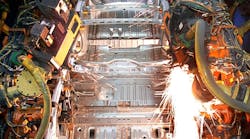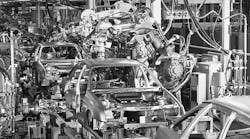The overall business climate in the electrical market is tough to gauge. Some regional markets, business segments and individual electrical distributors are on track for double-digit electrical sales increases in 2015. Others reflect the slow-growth environment of the overall U.S. economy, or are really suffering, like boom-and-bust oil markets.
A key market segment showing good — and in some market areas terrific — growth over the past year is the industrial market. It’s an important chunk of the overall electrical industry that in 2015 will account for no less than 17% of the $100-plus billion in sales through electrical distributors, according to Electrical Wholesaling data. The U.S. economy has changed over the past few decades to more of a service economy, and at roughly 12.4 million workers in June 2015 according to data from the U.S. Bureau of Labor Statistics (BLS), total manufacturing employment is down 36% from its peak employment level in 1979 of 19.4 million factory workers. But it has registered a 9% gain from the 2008-2010 recession, when it bottomed out at 12.2 million workers, as auto companies build new facilities and retrofit old ones to keep up with new demand.
More than any other state, Michigan reflects this resurgence. Its June 2015 BLS data showing 603,800 industrial workers and 3.1% YOY increase outpaces the 1.3% increase in total U.S. manufacturing employment over the same period. The state’s manufacturing employment numbers top the nation in large part because of renewed investment in factories by the Big Three auto manufacturers and the suppliers that feed them. For instance, according to an April 30 Associated Press post, General Motors is investing $520 million in its Delta Township plant near Lansing, Mich.; $245 million at its plant in Orion, Mich.; $139.5 million for a new body shop and metal stamping equipment in its Warren, Mich., plant; and $124 million for a retrofit of its metal stamping plant in Pontiac, Mich. And just this week GM announced that it would be investing $877 million in its truck plant in Flint, Mich.
Through June 2015, Michigan added 18,300 manufacturing jobs year-over-year (YOY) from June 2014, according to BLS data. It’s the biggest increase of any state, but Ohio and Indiana aren’t far behind, with YOY gains of 17,500 and 14,200 respectively. Another Upper Midwest state is among the nation’s leaders in industrial employment gains over the same period, as Wisconsin added 7,800 jobs.
Several of Michigan’s largest metropolitan statistical areas (MSAs) have individually added more manufacturing jobs over the past year than many states. The Detroit-Warren-Dearborn MSA added 8,500 manufacturing jobs, followed by the Grand Rapids-Wyoming MSA (4,800 jobs); Lansing-East Lansing (1,100 jobs); and Kalamazoo-Portage (900 jobs). The Detroit and Grand Rapids MSAs rank in the Top 10 MSAs for manufacturing employment growth over the past year (see chart on this page).
Other states are also seeing a surge of auto-related construction. CNN Money reported in May that Volvo will be building a new factory in Berkeley County, S.C., that will create 2,000 jobs over the next 10 years and up to 4,000 jobs by 2030, and that BMW is spending $1 billion to expand an existing facility in the state.
Nissan is also spending big bucks retrofitting its U.S. facilities, and according to a March article in The Tennessean, will invest $160 million in its Nissan North America supplier park in Smyrna, Tenn., a facility that reportedly will have 10 other suppliers feeding parts to the assembly lines at the Nissan factory.
While we are on the subject of massive auto facilities, don’t forget Tesla’s mega-factory in Nevada that will produce lithium ion batteries for its electric vehicles. A Reuters report said the factory will employ 6,500 factory works and is expected to create an additional 15,000 jobs at other suppliers and vendors for Tesla.
Although the resurgent auto industry currently hogs many of the headlines in the industrial market, construction of industrial chemical facilities is also on a tear, particularly on the Gulf Coast. Bloomberg Business cites data from the U.S. Census Bureau that said spending on chemical plant construction during the first five months of this year totaled $15.9 billion — more than double the $7 billion for the same period in 2014.
All this talk about employment increases is more than just idle chatter from stat dweeb because it translates directly into new sales potential. According to EW’s sales-per-employee data, each employee at a factory is worth $770 in industrial MRO sales potential and $787 in OEM sales potential.













